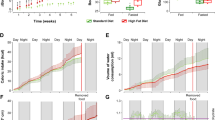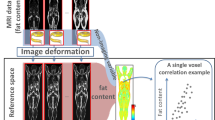Abstract
Body composition studies were first recorded around the time of the renaissance, and advances by the mid-twentieth century facilitated growth in the study of physiology, metabolism and pathological states. The field developed during this early period around the ‘two-compartment’ molecular level model that partitions body weight into fat and fat-free mass. Limited use was also made of X-rays as a means of estimating fat-layer thickness, but the revolutionary advance was brought about by the introduction of three-dimensional images provided by computed tomography (CT) in the mid 1970s, followed soon thereafter by magnetic resonance imaging (MRI). Complete in vivo reconstruction of all major anatomic body compartments and tissues became possible, thus providing major new research opportunities. This imaging revolution has continued to advance with further methodology refinements including functional MRI, diffusion tensor imaging and combined methods such as positron emission tomography+CT or MRI. The scientific advances made possible by these new and innovative methods continue to unfold today and hold enormous promise for the future of obesity research.
This is a preview of subscription content, access via your institution
Access options
Subscribe to this journal
Receive 12 print issues and online access
$259.00 per year
only $21.58 per issue
Buy this article
- Purchase on Springer Link
- Instant access to full article PDF
Prices may be subject to local taxes which are calculated during checkout




Similar content being viewed by others
References
Wang ZM, Wang ZM, Heymsfield SB . History of the study of human body composition: a brief review. Am J Hum Biol 1999; 11: 157–165.
Heymsfield SB, Lohman TG, Wang ZM, Going SB . Human Body Composition, 2nd edn. Human Kinetics: Champaign, IL, 2005.
Forbes GB . Human Body Composition. Growth, Aging, Nutrition and Activity. Springer-Verlag: New York, 1987.
Lohman TG, Roche AF, Martorell R (eds). Anthropometric Standardization Reference Manual. Human Kinetics: Champaign, III, 1988.
Stuart HC, Hill P, Shaw C . The growth of bone, muscle and overlying tissue as revealed by studies of roentgenograms of the leg area. Monogr Soc Res Child Dev 1940; 5: 1–190.
Garn SM . Roentgenogrammetric determinations of body composition. Hum Biol 1957; 29: 337–353.
Wang ZM, Pierson Jr RN, Heymsfield SB . The five-level model: a new approach to organizing body-composition research. Am J Clin Nutr 1992; 56: 19–28.
Hounsfield GN . Computerized transverse axial scanning (tomography). Br J Radiol 1973; 46: 1016–1022.
Raden J . On the determination of functions from their integrals along certain mainfolds. Math Phys Klasse 1917; 69: 262–277.
Heymsfield SB, Noel R, Lynn M, Kutner M . Accuracy of soft tissue density predicted by CT. J Comput Assist Tomogr 1979; 3: 859–860.
Heymsfield SB, Olafson RP, Kutner MH, Nixon DW . A radiographic method of quantifying protein-calorie undernutrition. Am J Clin Nutr 1979; 32: 693–702.
Heymsfield SB, Fulenwider BT, Nordlinger R, Balow R, Sones P, Kutner M . Accurate measurement of liver, kidney, and spleen volume and mass by computerized axial tomography. Ann Intern Med 1979; 90: 185–187.
Heymsfield SB, Noel R . Radiographic analysis of body composition by computerized axial tomography. In: Ellison NM, Newell GR (eds). Nutrition and Cancer, vol. 17. Raven Press: New York, 1981, pp 161–172.
Borkan GA, Gerzof SG, Robbins AH, Hults DE, Silbert CK, Silbert JE . Assessment of abdominal fat content by computerized tomography. Am J Clin Nutr 1982; 36: 172–177.
Tokunaga K, Matsuzawa Y, Ishikawa K, Tarui S . A novel technique for the determination of body fat by computed tomography. Int J Obes 1983; 7: 437–445.
Sjöström L, Kvist H, Cederblad A, Tylen U . Determination of total adipose tissue and body fat in women by computed tomography, 40K, and tritium. Am J Physiol 1986; 250: E736–E745.
Björntorp P . Adipose tissue distribution and function. Int J Obes 1991; 5 (Suppl 2): 67–81.
Bloch F, Hansen WW, Packard ME . Nuclear introduction. Phys Rev 1946; 70: 460–474.
Purcell EM, Torrey HC, Pound RV . Resonance absorption by nuclear magnetic moments in a solid. Phys Rev 1946; 69: 37–38.
Damadian R . Tumor detection by nuclear magnetic resonance. Science 1971; 171: 1151–1153.
Lauterber PC . Image formation by induced local interactions: examples employing nuclear magnetic resonance. Nature 1973; 242: 190–191.
Mansfield P . Multi-planar image formation using NMR spin-echoes. J Phys Chem 1977; 10: L55.
Foster MA, Hutchison JMS, Mallard JR, Fuller M . Nuclear magnetic resonance pulse sequence and discrimination of high-and low fat tissues. Magn Reson Imaging 1984; 2: 187–192.
Hayes PA, Sowood PJ, Belyavin A, Cohen JB, Smith FW . Subcutaneous fat thickness measured by magnetic resonance imaging, ultrasound, and calipers. Med Sci Sports Exerc 1988; 20: 303–309.
Ross R . Advances in the application of imaging methods in applied and clinical physiology. Acta Diabetol 2003; 40 (Suppl 1): S45–S50.
Fowler PA, Fuller MF, Glasby CA, Foster MA, Cameron GG, McNeill G et al. Total and subcutaneous adipose tissue distribution in women: the measurement of distribution and accurate prediction of quantity by using magnetic resonance imaging. Am J Clin Nutr 1991; 54: 18–25.
Ross R, Léger L, Morris D, de Guise J, Guardo R . Quantification of adipose tissue by MRI: relationship with anthropometric variables. J Appl Physiol 1992; 72: 787–795.
Ross R, Shaw KD, Martel J, de Guise Y, Avruch L . Adipose tissue distribution measured by magnetic resonance imaging in obese women. Am J Clin Nutr 1993; 57: 470–475.
Farooqi IS, Bullmore E, Keogh J, Gillard J, O’Rahilly S, Fletcher PC . Leptin regulates striatal regions and human eating behavior. Science 2007; 317: 1355.
Izhikevich EM, Edelman GM . Large-scale model of mammalian thalamocortical systems. Proc Natl Acad Sci 2008; 105: 3593–3598.
Petersen KF, Dufour S, Shulman GI . Decreased insulin-stimulated ATP synthesis and phosphate transport in muscle of insulin-resistant offspring of type 2 diabetic parents. PLoS Med 2005; 2: e233.
Kim H, Taksali SE, Dufour S, Befroy D, Goodman TR, Petersen KF et al. Comparative MR study of hepatic fat quantification using single-voxel proton spectroscopy, two-point dixon and three-point IDEAL. Magn Reson Med 2008; 59: 521–527.
Napolitano A, Miller SR, Murgatroyd PR, Coward WA, Wright A, Finer N et al. Validation of a quantitative magnetic resonance method for measuring human body composition. Obesity 2008; 16: 191–198.
Shen W, Wang Z, Punyanita M, Lei J, Sinav A, Kral JG et al. Adipose tissue quantification by imaging methods: a proposed classification. Obes Res 2003; 11: 5–16.
Erondu N, Gantz I, Musser B, Suryawanshi S, Mallick M, Addy C et al. Neuropeptide Y5 receptor antagonism does not induce clinically meaningful weight loss in overweight and obese adults. Cell Metab 2006; 4: 275–282.
Nedergaard J, Bengtsson T, Cannon B . Unexpected evidence for active brown adipose tissue in adult humans. Am J Physiol Endocrinol Metab 2007; 293: E444–E452.
Addy C, Wright H, Van Laere K, Gantz I, Erondu N, Musser BJ et al. The acyclic CB1R inverse agonist taranabant mediates weight loss by increasing energy expenditure and decreasing caloric intake. Cell Metab 2008; 7: 68–78.
Moore FD, Oleson KH, McMurray JD, Parker HV, Ball MR, Boyden CM . The Body Cell Mass and its Supporting Environment. WB Saunders: Philadelphia, 1963.
Anderson J, Osborn SB, Tomlinson RWS, Newton D, Rundo J, Salmon L et al. Neutron-activation analysis in man in vivo: a new technique in medical investigation. Lancet 1964; 2: 1201–1205.
Cameron JR, Sorenson J . Measurement of bone mineral in vivo. Science 1963; 42: 230–232.
Mazess RB, Barden HS, Bisek JP, Hanson J . Dual-energy X-ray absorptiometry for total-body and regional bone-mineral and soft-tissue composition. Am J Clin Nutr 1990; 51: 1106–11012.
Pietrobelli A, Formica C, Wang ZM, Heymsfield SB . Dual-energy X-ray absorptiometry body composition model: review of physical concepts. Am J Physiol 1996; 271: E941–E951.
Heymsfield SB, Smith R, Aulet M, Bensen B, Lichman S, Wang J et al. Appendicular skeletal muscle mass: measurement by dual-photon absorptiometry. Am J Clin Nutr 1990; 52: 214–218.
Tataranni PA, Ravussin E . Use of dual-energy X-ray absorptiometry in obese individuals. Am J Clin Nutr 1995; 62: 730–734.
Siri WE . Body composition from fluid spaces and density: analysis of method. In: Brozek J, Henschel A (eds). Techniques for Measuring Body Composition. National Academy of Sciences, National Research Council: Washington, DC, 1961, pp 223–244.
Heymsfield SB, Lichtman S, Baumgartner RN, Wang J, Kamen Y, Aliprantis A et al. Body composition of humans: comparison of two improved four-compartment models that differ in expense, technical complexity, and radiation exposure. Am J Clin Nutr 1990; 52: 52–58.
Acknowledgements
I acknowledge the outstanding creative and supportive collaborations that have provided the basis for my research program over the past three decades.
Author information
Authors and Affiliations
Corresponding author
Additional information
Conflict of interest
Steven B Heymsfield has declared no financial interests.
Rights and permissions
About this article
Cite this article
Heymsfield, S. Development of imaging methods to assess adiposity and metabolism. Int J Obes 32 (Suppl 7), S76–S82 (2008). https://doi.org/10.1038/ijo.2008.242
Published:
Issue Date:
DOI: https://doi.org/10.1038/ijo.2008.242
Keywords
This article is cited by
-
Billroth II anastomosis maintains SMI and BMI better than Roux-en-Y anastomosis following totally laparoscopic distal gastrectomy: a propensity score-matched study
Langenbeck's Archives of Surgery (2022)
-
Association between skeletal muscle loss and the response to nivolumab immunotherapy in advanced gastric cancer patients
International Journal of Clinical Oncology (2021)
-
Sarcopenia and fatty liver disease
Hepatology International (2019)
-
Diabetes and Impaired Fasting Glucose Prediction Using Anthropometric Indices in Adults from Maracaibo City, Venezuela
Journal of Community Health (2016)
-
Skeletal muscle loss after total gastrectomy, exacerbated by adjuvant chemotherapy
Gastric Cancer (2015)



